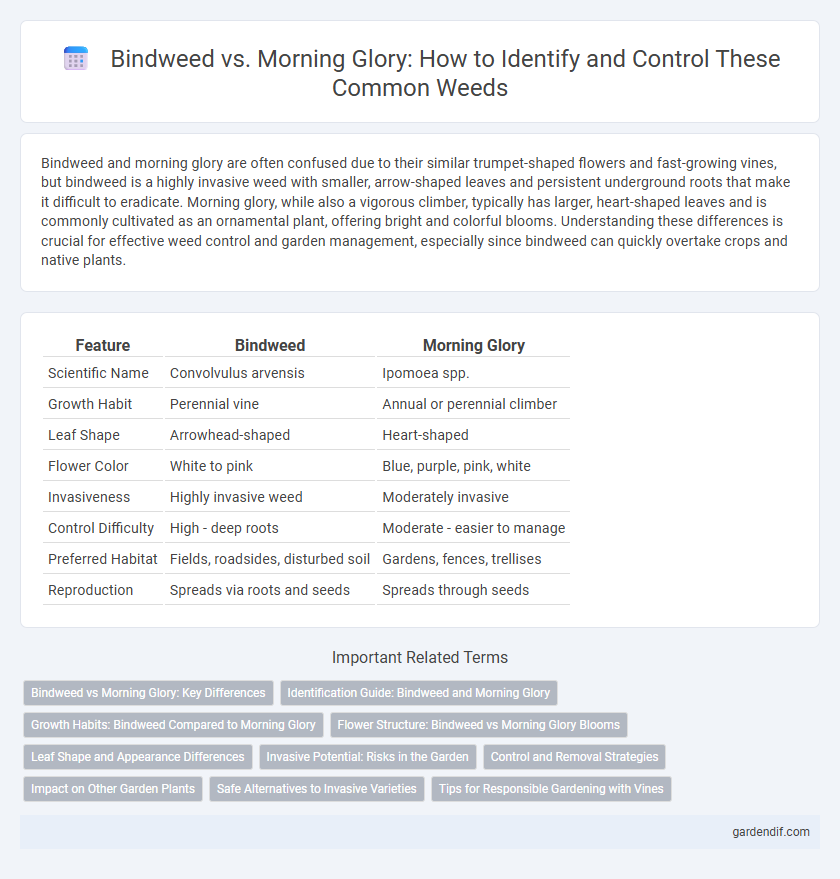
Bindweed vs morning glory Illustration
Bindweed and morning glory are often confused due to their similar trumpet-shaped flowers and fast-growing vines, but bindweed is a highly invasive weed with smaller, arrow-shaped leaves and persistent underground roots that make it difficult to eradicate. Morning glory, while also a vigorous climber, typically has larger, heart-shaped leaves and is commonly cultivated as an ornamental plant, offering bright and colorful blooms. Understanding these differences is crucial for effective weed control and garden management, especially since bindweed can quickly overtake crops and native plants.
Table of Comparison
| Feature | Bindweed | Morning Glory |
|---|---|---|
| Scientific Name | Convolvulus arvensis | Ipomoea spp. |
| Growth Habit | Perennial vine | Annual or perennial climber |
| Leaf Shape | Arrowhead-shaped | Heart-shaped |
| Flower Color | White to pink | Blue, purple, pink, white |
| Invasiveness | Highly invasive weed | Moderately invasive |
| Control Difficulty | High - deep roots | Moderate - easier to manage |
| Preferred Habitat | Fields, roadsides, disturbed soil | Gardens, fences, trellises |
| Reproduction | Spreads via roots and seeds | Spreads through seeds |
Bindweed vs Morning Glory: Key Differences
Bindweed and morning glory are often confused due to their similar trumpet-shaped flowers, but bindweed is typically more invasive with a stronger, twining vine that can choke out other plants rapidly. Morning glory usually has larger, more vibrant flowers and a less aggressive growth habit, making it popular in gardens, whereas bindweed is considered a noxious weed due to its persistence and difficulty to control. Key differences also include their leaf shapes--bindweed leaves tend to be arrow-shaped while morning glory leaves are heart-shaped--helping gardeners distinguish between the two species effectively.
Identification Guide: Bindweed and Morning Glory
Bindweed and morning glory both belong to the Convolvulaceae family, but bindweed typically has smaller, narrower leaves and white or pink funnel-shaped flowers, while morning glory features larger heart-shaped leaves and vibrant, trumpet-shaped blossoms in colors like purple, blue, and pink. Identifying bindweed involves noting its aggressive vine growth and twining habit around plants, whereas morning glory is often cultivated as an ornamental with less invasive tendencies. Accurate identification relies on observing leaf shape, flower color, and growth patterns to differentiate these frequently confused weeds.
Growth Habits: Bindweed Compared to Morning Glory
Bindweed exhibits aggressive, twining growth habits with extensive underground rhizomes that enable rapid spreading and strong soil anchorage. In contrast, morning glory tends to grow more moderately, climbing by wrapping stems around supports without as extensive root systems. Bindweed's persistent and invasive root network makes it significantly harder to control compared to morning glory, which is often cultivated for ornamental purposes.
Flower Structure: Bindweed vs Morning Glory Blooms
Bindweed flowers are typically smaller, funnel-shaped, and often white or pale pink, featuring a narrow tubular base that flares into five delicate lobes. Morning glory blooms are larger, trumpet-shaped with vibrant colors like purple, blue, and magenta, sporting a wider corolla that showcases a more pronounced radial symmetry. Both belong to the Convolvulaceae family but differ significantly in flower size, shape, and color intensity.
Leaf Shape and Appearance Differences
Bindweed leaves are typically arrowhead-shaped with slender, pointed tips, featuring smooth edges and a dull green hue, while morning glory leaves exhibit a more rounded or heart-shaped form with a glossy surface and pronounced veins. Bindweed vines often have smaller, narrower leaves compared to the broader, larger leaves of morning glory. The distinct leaf morphology helps in accurately differentiating bindweed from morning glory in weed identification and management.
Invasive Potential: Risks in the Garden
Bindweed exhibits a high invasive potential due to its aggressive root system that spreads rapidly and chokes out surrounding plants, making garden management challenging. Morning glory, while also a vigorous climber, tends to be less destructive below ground but can still dominate trellises and fences, limiting sunlight for other vegetation. Both weeds pose significant risks to garden biodiversity and require consistent control measures to prevent extensive damage.
Control and Removal Strategies
Effective control and removal strategies for bindweed involve persistent digging to remove its deep, rhizome-based root system, combined with the application of systemic herbicides targeted at perennial weeds. Morning glory control requires frequent hand-pulling before seed set and the use of mulch to suppress seedling emergence, while selective herbicides can be applied cautiously to avoid damaging nearby plants. Both weeds benefit from regular monitoring and integrated management to prevent reestablishment and spread in gardens and agricultural fields.
Impact on Other Garden Plants
Bindweed aggressively competes with garden plants by spreading rapidly through deep roots and dense foliage, choking out desirable vegetation and reducing garden biodiversity. Morning glory, while vigorous, generally grows more manageably on trellises or structures without overwhelming surrounding plants as extensively. Gardeners often find bindweed more detrimental due to its invasive growth habits that significantly compromise the health and yield of neighboring plants.
Safe Alternatives to Invasive Varieties
Bindweed and morning glory are both invasive weeds that can quickly overtake gardens, but safe alternatives include native species like Virginia creeper and sweet pea vine. Virginia creeper offers rapid growth with less aggressive rooting systems, preventing soil erosion without choking other plants. Sweet pea vine provides vibrant blooms and a manageable growth pattern, making it a safe ornamental choice for gardeners seeking to avoid invasive varieties.
Tips for Responsible Gardening with Vines
Control bindweed by regularly cutting back new growth and using mulch to suppress seedlings, preventing its aggressive spread. Morning glory requires careful pruning to maintain its decorative appeal without overtaking garden spaces, as it can climb extensively. Employ targeted herbicides selectively and ensure proper spacing to balance vine aesthetics with garden health, minimizing invasive tendencies.
Bindweed vs morning glory Infographic

 gardendif.com
gardendif.com